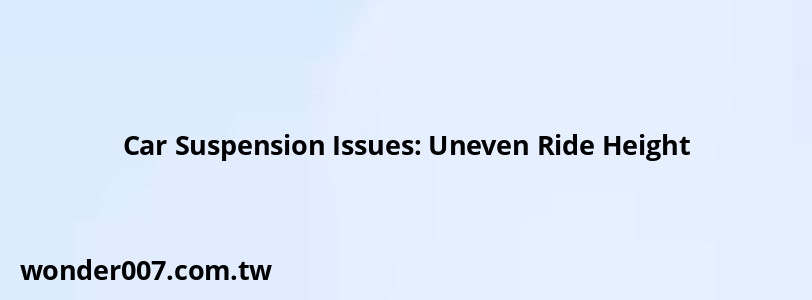Car Suspension Issues: Uneven Ride Height

Uneven Car Suspension
When one side of a car is lower than the other, it typically indicates a suspension problem. This issue can affect your vehicle's handling, safety, and overall performance. Several factors can contribute to this uneven ride height, ranging from simple wear and tear to more serious mechanical failures.
Common Causes
Worn Springs
One of the most frequent reasons for a car sitting lower on one side is worn or broken springs. Springs are crucial components of your car's suspension system, supporting the vehicle's weight and absorbing road shocks. Over time, these springs can weaken or break, causing the car to sag on the affected side.
Damaged Shocks or Struts
Faulty shocks or struts can also lead to an uneven ride height. These components work in tandem with the springs to control the car's bounce and sway. When they fail, they can no longer properly support the vehicle's weight, resulting in one side sitting lower than the other.Uneven Tire Pressure
Sometimes, the issue may be as simple as uneven tire pressure. If one tire has significantly less air than the others, it can cause that corner of the car to sit lower. Always check your tire pressure regularly and ensure all tires are inflated to the manufacturer's recommended levels.
Diagnosis and Solutions
Visual Inspection
Start by visually inspecting your vehicle. Look for any obvious signs of damage or wear in the suspension components. Check if the car appears to be leaning to one side when parked on a level surface.
Professional Diagnosis
For a more accurate diagnosis, it's best to have your car inspected by a qualified mechanic. They can perform a thorough examination of your suspension system and identify the root cause of the problem.
Repairs and Replacements
Depending on the cause, solutions may include:
- Replacing worn or broken springs
- Installing new shocks or struts
- Correcting tire pressure
- Addressing any other suspension component issues
Importance of Timely Repairs
Driving with uneven suspension can lead to:
- Uneven tire wear
- Poor handling and stability
- Increased risk of accidents
- Additional strain on other suspension components
It's crucial to address this issue promptly to ensure your safety and prevent further damage to your vehicle.
FAQs About Uneven Car Suspension
- Can I drive my car if one side is lower?
While you can drive short distances, it's not recommended for extended periods as it can lead to further damage and safety risks. - How often should I check my car's suspension?
It's advisable to have your suspension checked during regular maintenance, typically every 50,000 miles or if you notice any changes in your car's handling. - Can uneven suspension affect my car's alignment?
Yes, uneven suspension can cause alignment issues, leading to uneven tire wear and poor handling.
Related Posts
-
How to Inflate Air Suspension on Lincoln Town Car
29-01-2025 • 164 views -
Seat Belt Issues: Fixing a 2013 Ford Escape That Won't Retract
27-01-2025 • 208 views -
GMC Terrain Remote Start Issues: Troubleshooting Guide
29-01-2025 • 227 views -
Jeep Grand Cherokee Push Button Start Issues: Troubleshooting Guide
28-01-2025 • 308 views -
2006 Chevy Impala: Front Suspension Diagram and Guide
30-01-2025 • 179 views
Latest Posts
-
Rear Brake Caliper Piston Won't Compress
01-02-2025 • 361 views -
Power Steering Fluid Leak On Passenger Side
01-02-2025 • 461 views -
2015 Chevy Traverse AC Recharge Port Location
01-02-2025 • 417 views -
How To Turn Off Paddle Shifters Mercedes
01-02-2025 • 387 views -
Are O2 Sensors Covered Under Warranty
01-02-2025 • 378 views
Popular Posts
-
EPC Light: Understanding Causes and Solutions
26-01-2025 • 1065 views -
Hino Warning Lights: Understanding Dashboard Alerts
26-01-2025 • 794 views -
V12 Engine Costs: What You Need to Know
26-01-2025 • 688 views -
Power Steering and ABS Light On: Causes and Solutions
27-01-2025 • 649 views -
Toyota Hiace: Fuel Efficiency Insights for 2025
26-01-2025 • 645 views
